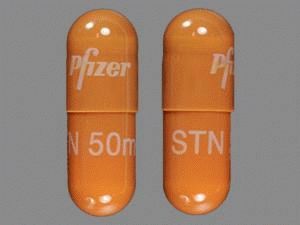索坦硬胶囊SUTENT 37.5mg Hard Capsules(Sunitinib Malate)
 产地国家:英国
处方药:是
所属类别: 37.5毫克/胶囊 28胶囊/瓶
包装规格: 37.5毫克/胶囊 28胶囊/瓶
计价单位:瓶
生产厂家英文名:Pfizer
原产地英文商品名:SUTENT Hard Capsules 37.5mg/Capsule 28Capsules/bottle
原产地英文药品名:SUNITINIB MALATE
中文参考商品译名:索坦硬胶囊 37.5毫克/胶囊 28胶囊/瓶
中文参考药品译名:苹果酸舒尼替尼
产地国家:英国
处方药:是
所属类别: 37.5毫克/胶囊 28胶囊/瓶
包装规格: 37.5毫克/胶囊 28胶囊/瓶
计价单位:瓶
生产厂家英文名:Pfizer
原产地英文商品名:SUTENT Hard Capsules 37.5mg/Capsule 28Capsules/bottle
原产地英文药品名:SUNITINIB MALATE
中文参考商品译名:索坦硬胶囊 37.5毫克/胶囊 28胶囊/瓶
中文参考药品译名:苹果酸舒尼替尼
简介:
苹果酸舒尼替尼硬胶囊(sunitinibmalate)它是第一个批准的MRCC一线用药,也是第一个能够选择性地针对多种酪氨酸激酶受体的新型靶向药物最先是由美国辉瑞公司开发的一种口服小分子多靶点酪氨酸激酶受体抑制剂。分别于2006年1月和2007年1月及2008年6月由美国FDA和欧洲EMEA及日本批准上市,商品名为Sutent,为口服硬明胶胶囊制剂,用于治疗胃肠道问质肿瘤(GIST)和晚期肾细胞瘤。 苹果酸舒尼替尼本品能抑制至少8种与肿瘤相关的受体酪氨酸激酶,以及肿瘤血管生长因子,对于肿瘤生长、细胞表达、转移显示出很强的抑制作用,在化疗或放疗的同时,使用舒尼替尼有助于增强抗肿瘤疗效。它对乳腺癌,结肠直肠癌、前列腺癌和非小细胞肺癌的临床试验正在进行中。英文版说明书:
SUTENT 12.5mg, 25mg, 37.5mg and 50mg Hard Capsules1. Name of the medicinal productSUTENT 12.5 mg hard capsulesSUTENT 25 mg hard capsulesSUTENT 37.5 mg hard capsulesSUTENT 50 mg hard capsules2. Qualitative and quantitative compositionSUTENT 12.5 mg hard capsulesEach capsule contains sunitinib malate, equivalent to 12.5 mg of sunitinib.SUTENT 25 mg hard capsulesEach capsule contains sunitinib malate, equivalent to 25.0 mg of sunitinib.SUTENT 37.5 mg hard capsulesEach capsule contains sunitinib malate, equivalent to 37.5 mg of sunitinib.SUTENT 50 mg hard capsulesEach capsule contains sunitinib malate equivalent to 50 mg of sunitinib.For the full list of excipients, see section 6.1.3. Pharmaceutical formSUTENT 12.5 mgHard capsule.Gelatin capsules with orange cap and orange body, printed with white ink “Pfizer” on the cap, “STN 12.5 mg” on the body, and containing yellow to orange granules.SUTENT 25 mgHard capsule.Gelatin capsules with caramel cap and orange body, printed with white ink “Pfizer” on the cap, “STN 25 mg”on the body and containing yellow to orange granules.SUTENT 37.5 mgHard capsule.Gelatin capsules with yellow cap and yellow body, printed with black ink “Pfizer” on the cap, “STN 37.5 mg” on the body and containing yellow to orange granules.SUTENT 50 mgHard capsule.Gelatin capsules with caramel cap and caramel body, printed with white ink “Pfizer” on the cap, “STN 50 mg” on the body and containing yellow to orange granules.4. Clinical particulars4.1 Therapeutic indicationsGastrointestinal stromal tumour (GIST)SUTENT is indicated for the treatment of unresectable and/or metastatic malignant gastrointestinal stromal tumour (GIST) in adults after failure of imatinib treatment due to resistance or intolerance.Metastatic renal cell carcinoma (MRCC)SUTENT is indicated for the treatment of advanced/metastatic renal cell carcinoma (MRCC) in adults.Pancreatic neuroendocrine tumours (pNET)SUTENT is indicated for the treatment of unresectable or metastatic, well-differentiated pancreatic neuroendocrine tumours (pNET) with disease progression in adults.Experience with SUTENT as first-line treatment is limited (see section 5.1).4.2 Posology and method of administrationTherapy with sunitinib should be initiated by a physician experienced in the administration of anti-cancer agents.PosologyFor GIST and MRCC, the recommended dose of SUTENT is 50 mg taken orally once daily, for 4 consecutive weeks, followed by a 2-week rest period (schedule 4/2) to comprise a complete cycle of 6 weeks.For pNET, the recommended dose of SUTENT is 37.5 mg taken orally once daily without a scheduled rest period.Dose adjustmentsSafety and tolerabilityFor GIST and MRCC, dose modifications in 12.5 mg steps may be applied based on individual safety and tolerability. Daily dose should not exceed 75 mg nor be decreased below 25 mg.For pNET, dose modification in 12.5 mg steps may be applied based on individual safety and tolerability. The maximum dose administered in the Phase 3 pNET study was 50 mg daily.Dose interruptions may be required based on individual safety and tolerability.CYP3A4 inhibitors/inducersCo-administration of sunitinib with potent CYP3A4 inducers, such as rifampicin, should be avoided (see sections 4.4 and 4.5). If this is not possible, the dose of sunitinib may need to be increased in 12.5 mg steps (up to 87.5 mg per day for GIST and MRCC or 62.5 mg per day for pNET) based on careful monitoring of tolerability.Co-administration of sunitinib with potent CYP3A4 inhibitors, such as ketoconazole, should be avoided (see sections 4.4 and 4.5). If this is not possible, the dose of sunitinib may need to be reduced to a minimum of 37.5 mg daily for GIST and MRCC or 25 mg daily for pNET, based on careful monitoring of tolerability.Selection of an alternative concomitant medicinal product with no or minimal potential to induce or inhibit CYP3A4 should be considered.Special populationsPaediatric populationThe safety and efficacy of sunitinib in patients below 18 years of age have not been established.No data are available.There is no relevant use of sunitinib in children from birth to less than 6 years in the indication of unresectable and/or metastatic malignant gastrointestinal stromal tumour (GIST) after failure of imatinib treatment due to resistance or intolerance. There is no relevant use of sunitinib in the paediatric population in the indications treatment of advanced/metastatic renal cell carcinoma (MRCC) and treatment of unresectable or metastatic, well-differentiated pancreatic neuroendocrine tumours (pNET) with disease progression.Use of sunitinib in the paediatric population is not recommended.Elderly patients (≥65 years old)Approximately one-third of the patients in clinical studies who received sunitinib were 65 years of age or over. No significant differences in safety or efficacy were observed between younger and older patients.Hepatic impairmentNo starting dose adjustment is recommended when administering sunitinib to patients with mild or moderate (Child-Pugh class A and B) hepatic impairment. Sunitinib has not been studied in subjects with severe (Child-Pugh class C) hepatic impairment and therefore its use in patients with severe hepatic impairment cannot be recommended (see section 5.2).Renal impairmentNo starting dose adjustment is required when administering sunitinib to patients with renal impairment (mild-severe) or with end-stage renal disease (ESRD) on haemodialysis. Subsequent dose adjustments should be based on individual safety and tolerability (see section 5.2).Method of administrationSUTENT is for oral administration. It may be taken with or without food.If a dose is missed the patient should not be given an additional dose. The patient should take the usual prescribed dose on the following day.4.3 ContraindicationsHypersensitivity to the active substance or to any of the excipients listed in section 6.1.4.4 Special warnings and precautions for useCo-administration with potent CYP3A4 inducers should be avoided because it may decrease sunitinib plasma concentration (see sections 4.2 and 4.5).Co-administration with potent CYP3A4 inhibitors should be avoided because it may increase the plasma concentration of sunitinib (see sections 4.2 and 4.5).Skin and tissue disordersSkin discolouration, possibly due to the active substance colour (yellow), is a very common adverse reaction occurring in approximately 30% of patients. Patients should be advised that depigmentation of the hair or skin may also occur during treatment with sunitinib. Other possible dermatologic effects may include dryness, thickness or cracking of the skin, blisters, or occasional rash on the palms of the hands and soles of the feet.The above reactions were not cumulative, were typically reversible and generally did not result in treatment discontinuation.Cases of pyoderma gangrenosum, generally reversible after drug discontinuation, have been reported.Severe cutaneous reactions have been reported, including cases of erythema multiforme (EM) and cases suggestive of Stevens-Johnson syndrome (SJS) and toxic epidermal necrolysis (TEN), some of which were fatal. If signs or symptoms of SJS, TEN, or EM (e.g. progressive skin rash often with blisters or mucosal lesions) are present, sunitinib treatment should be discontinued. If the diagnosis of SJS or TEN is confirmed, treatment must not be re-started. In some cases of suspected EM, patients tolerated the reintroduction of sunitinib therapy at a lower dose after resolution of the reaction; some of these patients also received concomitant treatment with corticosteroids or antihistamines.Haemorrhage and tumour bleedingHaemorrhagic events, some of which were fatal, reported through post-marketing experience have included gastro-intestinal, respiratory, urinary tract and brain haemorrhages.Bleeding events occurred in 18% of patients receiving sunitinib in a phase 3 GIST Study compared to 17% of patients receiving placebo. In patients receiving sunitinib for treatment-na?ve MRCC, 39% had bleeding events compared to 11% of patients receiving IFN-α. Seventeen (4.5%) patients on sunitinib versus 5 (1.7%) of patients on IFN-α experienced Grade 3 or greater bleeding events. Of patients receiving sunitinib for cytokine-refractory MRCC, 26% experienced bleeding. Bleeding events, excluding epistaxis, occurred in 21.7% of patients receiving sunitinib in the phase 3 pNET study compared to 9.85% of patients receiving placebo. Routine assessment of this event should include complete blood counts and physical examination.Epistaxis was the most common haemorrhagic adverse reaction, having been reported for approximately half of the patients with solid tumours who experienced haemorrhagic events. Some of the epistaxis events were severe, but very rarely fatal.Events of tumour haemorrhage, sometimes associated with tumour necrosis, have been reported; some of these haemorrhagic events were fatal.In clinical trials, tumour haemorrhage occurred in approximately 2% of patients with GIST. These events may occur suddenly, and in the case of pulmonary tumours, may present as severe and life-threatening haemoptysis or pulmonary haemorrhage. Cases of pulmonary haemorrhage, some with a fatal outcome, have been observed in clinical trials and have been reported in post-marketing experience in patients treated with sunitinib for MRCC, GIST and lung cancer. SUTENT is not approved for use in patients with lung cancer.Patients receiving concomitant treatment with anticoagulants (e.g. warfarin, acenocoumarole) may be periodically monitored by complete blood counts (platelets), coagulation factors (PT/INR) and physical examination.Gastrointestinal disordersDiarrhoea, nausea/vomiting, abdominal pain, dyspepsia and stomatitis/oral pain were the most commonly reported gastrointestinal adverse reactions; oesophagitis events have been also reported (see section 4.8).Supportive care for gastrointestinal adverse reactions requiring treatment may include medicinal products with anti-emetic, anti-diarrhoeal or antacid properties.Serious, sometimes fatal gastrointestinal complications including gastrointestinal perforation have occurred in patients with intra-abdominal malignancies treated with sunitinib. Fatal gastrointestinal bleeding occurred in 0.98% of patients receiving placebo in the GIST phase 3 study.HypertensionHypertension was a very common adverse reaction reported in clinical trials.The dose of sunitinib was reduced or its administration temporarily suspended in approximately 2.7% of the patients who experienced hypertension. In none of these patients sunitinib was permanently discontinued. Severe hypertension (>200 mmHg systolic or 110 mmHg diastolic) occurred in 4.7% of patients with solid tumours. Hypertension was reported in approximately 33.9用药温馨提示:当您服用此药物时,需定期接受医疗专业人士的检查,以便随时针对其药效、副作用等情况进行监测。本网站所包含的信息旨在为患者提供帮助,不能代替医学建议和治疗。
药品价格查询,专业药品查询网站,药品说明书查询,药品比价 » 索坦硬胶囊SUTENT 37.5mg Hard Capsules(Sunitinib Malate)
药品价格查询,专业药品查询网站,药品说明书查询,药品比价 » 索坦硬胶囊SUTENT 37.5mg Hard Capsules(Sunitinib Malate)




